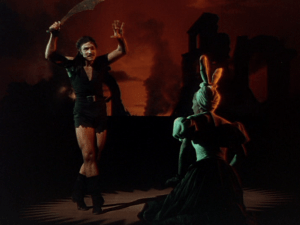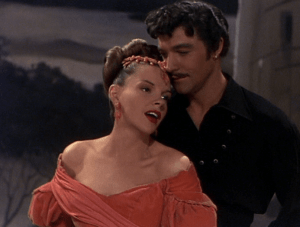
Vincente Minnelli’s quirky musical The Pirate may not have been appreciated when it was first released, but over the years, the film has become vindicated in its blend of lush production values, delightfully madcap performances from Judy Garland and Gene Kelly, and a charming Cole Porter score. The Pirate isn’t going to be everyone’s cup of tea, though. It’s much too stylized and the characterizations are sure to be called “over-the-top,” which is fair. However, there is a subtlety that works with the louder moments to convey a sensuality that seems to go unnoticed. If you’ve seen the film, you might be thinking What are you talking about? This is the movie that gave us Gene Kelly in hot pants! Well, yeah. But there are other things bubbling beneath the surface that make The Pirate a film about sex.
It begins with Manuela (Garland) breathlessly talking about infamous pirate Macoco as she wonders where he is and what he is doing. Right away we see that Manuela longs for travel and romance, things that are denied her when her Aunt Inez (Gladys Cooper) informs her that she has been betrothed to Don Pedro Vargas (Walter Slezak), the town’s mayor. Although Don Pedro is rich and an esteemed member of the community, he isn’t exactly a dreamboat. To make matters worse, he no longer cares for travel so Manuela is destined to be stuck in her small Caribbean village for a long, long time.
Manuela is told she is silly for wishing for whimsy and love. She is a testament to the idea that you can be sensible and still have an imagination. As she tells her aunt, “I realize that there’s a practical world and a dream world. I know which is which. I shan’t mix them.” Aunt Inez scolds her for being ungrateful about her engagement to Don Pedro, especially when Manuela asks to go to Port Sebastian when her trousseau comes in so she can see the sea one last time. Aunt Inez reluctantly agrees to this, but as the film goes on, she lives to regret it. For Manuela, the sea is magical — unruly and wild, it can’t be told what to do or who to be. The joy on her face as she watches the waves crash combines with the mounting music to mimic the dizzying adoration that Manuela feels.
While our heroine is gazing at the sea, traveling entertainer Serafin (Kelly) is gazing at her. Serafin is the ultimate ham. Obnoxious and brash, he rarely does anything with quiet dignity. For his first number, Serafin presents himself as the ultimate ladies’ man. He’s been with so many women, in fact, that he doesn’t even bother learning their names, instead calling them “Nina.” The resulting routine displays Serafin’s libido, charm, and sex appeal as he slinks his way around the village, entrancing women left and right. You can’t tell me that Gene Kelly wasn’t aware of the effect that he would have on female viewers with this song and dance. “Nina” is a lot of fun to watch, and the lyrics are classic Cole Porter — I mean, the man seamlessly integrates the word “neurasthenia” into the tune! Making the number even more memorable is Kelly’s dancing. He saw the film’s time period as a welcome challenge because tap dance hadn’t been invented yet, forcing him to rely on ballet and Latin dances like the tango.
The moment when Manuela and Serafin meet is fascinating to me because of the way Minnelli staged it. (No surprise there — the director always did a stellar job of this.) Manuela enters the frame, pausing to catch her breath when she first sees the Caribbean Sea. As she walks forward and out of the frame, the camera stays to reveal that Serafin was right behind her, stunned by her beauty. It’s also the precise second when he exhales cigarette smoke, as if Manuela makes him literally hot under the collar. The irony of their meeting is that Serafin is offering Manuela what she seems to want — excitement, intrigue, passion — but she is not amused. When she rejects his sudden proclamation of love, he remarks, “Oh, I see. You find enough romance in daydreams. … I know that underneath that prim exterior there are depths of emotion, romantic longings, unfulfilled dreams.” Annoyed, Manuela walks off in a huff, but not before the wind blows off her white hat and soaks it in the mud. Is it a coincidence that her “pure” hat becomes sullied when she encounters the promiscuous Serafin? Probably not.
That night, Manuela’s hotel room is unbearably hot. Opening the window, it’s almost like she has located the cause of the heat when she hears Serafin’s show happening below. She decides to join the rapt audience, which pleases a smug Serafin to no end. Determined to demonstrate to her that she is attracted to him, he presents a spinning mirror that is described as an experiment in animal magnetism. The hypnotism works, but instead of declaring Serafin to be her object of affection, she admits her feelings of lust for Macoco.
Unable to keep quiet about her love for Macoco, Manuela bursts into “Mack the Black,” illustrating that Serafin was right about what lies behind her rigidity. With her hair loose and her skirt swirling around to show off her legs, Manuela only endears herself more to Serafin. Originally, this number was supposed to be far more sexual, but MGM was horrified at the results. Studio head Louis B. Mayer reportedly demanded the footage be burned immediately, so the only remnant of it seems to be audio of the song that “Mack the Black” replaced, “Voodoo.” “Mack the Black” is still suggestive, though. The steamiest part of it might be the ending, when Serafin kisses Manuela to bring her out of the trance and her body slowly gives in. Now awake, Manuela is horrified and runs back to her hotel to beg Aunt Inez to return home as soon as possible.
A week goes by and Manuela’s wedding day has arrived. Told by Inez that she can “make anything come true by wishing hard enough for it,” Manuela pulls out the hat she was wearing when she met Serafin and begins laughing to herself. When she hears the arrival of Serafin’s troupe, it is like Manuela wished for the actor to appear, although she would never admit it. When he climbs into her bedroom, she tries to explain that she has “nothing but horror and shame” for her uninhibited performance the other night. “Horror? Shame? You were wonderful!” Serafin responds. Unlike everyone else, he encourages Manuela’s “inappropriate” behavior; she would be suffocated otherwise.
In a surprising twist, Serafin discovers that Don Pedro is Macoco, which gives the actor the idea to masquerade as the pirate to win Manuela’s affection. Unaware that his fiancée is enamored with his alter ego, Don Pedro goes along with the scheme to keep his respectability intact. As Macoco, Serafin becomes calm, cool, and collected. His manic energy is brought down to a simmer, allowing Manuela to believe that he is the fierce, fearsome pirate she loves. As the two of them make eyes at one another, their electric connection is felt by Don Pedro, who watches in desperation (“Do you two realize I’m in the room?!”).
Thoroughly swept off her feet, Manuela finds herself fantasizing about Serafin, giving us the scene that makes The Pirate so blatantly sexual. Watching him from her bedroom window, Manuela begins imagining him in full piratical action. Reality becomes blurred as Serafin is transformed into a dastardly buccaneer decked out in all black — and the shortest of shorts. According to Gene Kelly’s widow, Patricia Ward Kelly, Gene purposely chose tight clothing for a lot of his costumes because it showed off his physique, proving that dancing required insane athleticism. It also made him into eye candy, which he didn’t seem to mind. The number may be ridiculous and cheesy, but Kelly sells it. Channeling heroes Douglas Fairbanks and John Barrymore, he is graceful, attractive, and captivating. One second he is swinging in the air, the next he is throwing around a sword with abandon. Out of all of his routines, The Pirate‘s fantasy ballet gave Gene the most fan mail.
Manuela’s enchantment with Serafin is soon broken when one of the troupers lets the truth about his identity slip out. Brimming with anger, she gets her revenge by first playing along with Serafin. Echoing the way he kept circling her with wandering eyes by the sea, she walks around him and purrs, “I want to gaze my full at you.” The reversal makes Serafin fidget… and he hasn’t even gotten the worst of it yet. Luring him into a room full of delicate treasures, Manuela unleashes her wild side, but it doesn’t enthrall Serafin this time — probably because it involves throwing anything and everything right at his head. It’s a magnificent scene, one that ends with Serafin getting knocked out with a painting. Manuela quickly feels remorse and realizes that she may just love the crazy actor after all. Singing “You Can Do No Wrong,” she sweetly cradles Serafin’s head in her lap and they embrace.
Furious with the liberties Serafin is taking as Macoco, Don Pedro frames him for his past crimes and gets him arrested. At his execution, Serafin convinces the viceroy to let him put on one final show. After mystifying everyone with “Be a Clown,” a jaw-dropping acrobatic routine done with the Nicholas Brothers, Serafin brings out his spinning mirror to hypnotize Don Pedro into admitting that he is the real Macoco. When the mirror is broken, Manuela is forced to improvise and pretends to be under the mirror’s spell. Gushing about her love for Macoco and vowing her devotion, she sings “Love of My Life” as Don Pedro becomes increasingly jealous. Garland and Kelly drape themselves over each other, making the number incredibly tender and erotic. When the song ends with Manuela and Serafin sharing a kiss, Don Pedro can stand it no longer and loudly declares that he is the true Macoco. As you can probably guess, Don Pedro doesn’t quite get the happy ending he wants — but Serafin and Manuela do!
The Pirate is a giddy, crazy film. If you take it 100% seriously, you’re doing yourself a great disservice. I can’t guarantee that you’ll love it, but you can at least appreciate the exquisite craftsmanship that went into it. You’re just not liable to see anything else quite like it, then or now. Simply put, to me The Pirate can do no wrong.
You can catch Gene Kelly alongside Shirley MacLaine and an all-star cast in the wonderful comedy What a Way to Go! at the IU Cinema on October 7. The screening will be part of the Sunday Matinee Classics series, formerly known as Monday Matinee Classics.
The Cinema has shown some of Gene Kelly’s finest films, including Singin’ in the Rain in 2014, Minnelli’s An American in Paris in 2017, Cover Girl in 2018, and The Young Girls of Rochefort in 2014, a screening that was part of actor George Chakiris’s visit to the Cinema.
Previous Judy Garland movies that have been screened at the Cinema are Judgment at Nuremberg in 2013; Minnelli’s Meet Me in St. Louis in 2013; and The Wizard of Oz in 2016.

Michaela Owens is thrilled to be the editor of A Place for Film. An IU graduate with a BA in Communication and Culture, she is pursuing an MA in Cinema and Media Studies and has also been a volunteer usher at IU Cinema since 2016. She never stops thinking about classic Hollywood, thanks to her mother’s introduction to it, and she likes to believe she is an expert on Katharine Hepburn.















